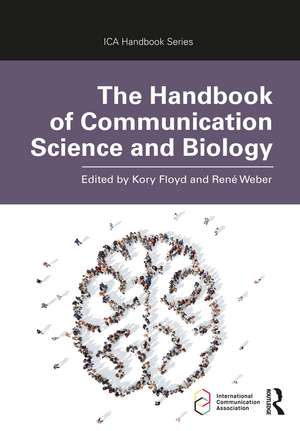The Handbook of Communication Science and Biology: ICA Handbook Series
Autor Kory Floyd, Rene Weberen Limba Engleză Paperback – 21 mai 2020
The Handbook of Communication Science and Biology charts the state of the art in the field, describing relevant areas of communication studies where a biological approach has been successfully applied. The book synthesizes theoretical and empirical development in this area thus far and proposes a roadmap for future research.
As the biological approach to understanding communication has grown, one challenge has been that research focused on media use/media effects and research focused on interpersonal/organizational communication have evolved separately and largely independently, often with little intellectual conversation between the two areas. The Handbook of Communication Science and Biology is the only book to bridge the gap between media studies and human communication and spur new work on both areas of focus.
With contributions from foremost scholars around the globe, this unique book comprehensively charts the field and sets the agenda for future research on the biological dimensions of communication behavior. Providing readers with an overview of the current state of affairs in this evolving field across its diverse epistemological, theoretical and methodological traditions, it serves as a seminal resource for the training of the current and next generation of communication scientists.
Preț: 690.07 lei
Preț vechi: 811.85 lei
-15% Nou
132.04€ • 138.23$ • 109.26£
Carte tipărită la comandă
Livrare economică 07-21 aprilie
Specificații
ISBN-10: 0815376731
Pagini: 524
Ilustrații: 46
Dimensiuni: 178 x 254 x 27 mm
Greutate: 1.01 kg
Ediția:1
Editura: Taylor & Francis
Colecția Routledge
Seria ICA Handbook Series
Locul publicării:Oxford, United Kingdom
Public țintă
PostgraduateCuprins
Notă biografică
René Weber is Professor of Communication at the University of California Santa Barbara and the Director of UCSB’s Media Neuroscience Lab (http://medianeuroscience.org).
Recenzii
"Scientific research on the connections between the brain, biology, and social behavior is among the most cutting-edge inquiry taking place in the communication discipline today. Floyd and Weber have gathered the most influential scholars in that field and highlighted their contributions in the Handbook of Communication Science and Biology. This significant volume pushes the boundaries of neuroscience and communication science and offers guidance and resources for anyone seeking to understand how the mind and body intersect with human communication behavior. This contemporary text is sure to be valuable to scholars and students alike." — Michael Gazzaniga, Distinguished Professor of Psychology and Director of the SAGE Center for the Study of the Mind, University of California, Santa Barbara, USA
"Communication science and biology is one of the latest and most prominent extensions of the communication discipline, founded by a group of young, brilliant, and interdisciplinary-minded scholars who have successfully established a new interest group within the International Communication Association. Floyd and Weber now provide what I am sure will soon become the key volume of this area." — Peter Vorderer, Professor of Media and Communication Studies; Fellow and former President of the International Communication Association
Descriere
The Handbook of Communication Science and Biology charts the state of the art in the field, describing relevant areas of communication studies where a biological approach has been successfully applied. The book synthesizes theoretical and empirical development in this area thus far and proposes a roadmap for future research.
As the biological approach to understanding communication has grown, one challenge has been that research focused on media use/media effects and research focused on interpersonal/organizational communication have evolved separately and largely independently, often with little intellectual conversation between the two areas. The Handbook of Communication Science and Biology is the only book to bridge the gap between media studies and human communication and spur new work on both areas of focus.
With contributions from foremost scholars around the globe, this unique book comprehensively charts the field and sets the agenda for future research on the biological dimensions of communication behavior. Providing readers with an overview of the current state of affairs in this evolving field across its diverse epistemological, theoretical and methodological traditions, it serves as a seminal resource for the training of the current and next generation of communication scientists.












